Death Valley Double Century
This was my first ultra-marathon bicycle ride of the new millennium and first 11+ mile ride on the new Reynolds Wishbone recumbent. I had been here three years ago during the 1997 Death Valley Double, in which I actually had to walk up parts of Salsberry Pass–the very last time I ever had to walk my bike up a hill. And that was with Canny, my faithful Cannondale I had ridden for years and thousands of miles.
But his year I had only ridden the Reynolds Wishbone for a grand total of 25 miles “testing” miles, with no significant hills. A recipe for disaster? A feat for the lunatic? Or, a promise for a grand weekend adventure? The optimist in me hoped for the latter.
The Drive
The drive looked less risky, at least compared to three years ago. This year I would be driving Lina, a new BMW Z3, as opposed to Goldie, a 1969 MGB. Still, it would be the first time trying to carry the recumbent on a 2-seat convertible. The night before I successfully set everything up using a Rhode Gear bicycle rack provided by a friend. Thanks again, Melissa.
Nevertheless, the drive was largely uneventful, taking just 8.5 hours this year, as opposed to 16 hours in 1997. It helps not to get lost and not take “shortcuts.” And have directions with me this time. I arrived at the Furnace Creek Resort at 12:15 a.m.
Before the Ride
Upon getting to the start I talked with another rider who just arrived. We found a campground to park in. The other rider commented that he “didn’t think it would be this dark outside” and that he regretted not bringing lights. He asked me if I brought a light. “Yes,” I replied. “There definitely aren’t going to be any streetlights around. Unfortunately, my high-powered lights just came in the mail five minutes before I took off from the Bay Area and I didn’t have time to recharge them, so I just brought my 2-watt Vistalight. It’s wimpy and is only good for three or four hours, but I’m not too concerned.” A statement that would haunt me later?
Anyhow, I slept for three hours in the Z3 and woke up at 3:30 a.m. I changed and almost an hour later was attempting to ride out of the campgrounds over loose sand. I felt a bit shaky, not having ridden the recumbent much at all. Just mounting the bike was difficult. And gosh, it really was dark. I wondered if this was a good idea to be riding from a safety standpoint. Hopefully during the many hours ahead I would feel more at ease with riding the recumbent?
The Ride
Miles 0-25
I registered and was on the road by 4:40 a.m. I noticed on the map that the ride started out with an out-and-back course to Stovepipe Wells, meaning that by Mile 50 we would be exactly where we started from. That put me more at ease as I knew I could abandon the ride at Mile 50 if need be and my car will be right there to take me home. I was seriously considering this scenario. But I told myself I would make the decision at that time and not now.
On the road. Scores of riders were already ahead of me, as evidenced by their blinking taillights. Many more were to catch me. By Mile 7 my legs were already very, very tight. This was the first time I use my a hydration system—a “Camelback” made by Performance Bicycle Shop that I bungeed onto the back of the seat. It worked okay. Unfortunately, I didn’t feel stable enough to ride too often with one hand, which also made blowing my nose or grabbing a protein bar out of the vest pockets difficult.
A note about my gray vest: It was actually a present from a 77-years-young friend in Stockton who gave it to me the weekend before. He got it because he thought it looked nice and had the word Bike on it as the manufacturer. It is made of fleece and has side pockets which have zippers on it. He had no idea but it was perfect for a recumbent, which rendered the rear pockets of my cycling jerseys useless. This was such a stroke of good luck to have this, looking back. Thank you, Frank.
Anyhow, about an hour passes when I decided that I really needed to take a leak, so I pulled over to the side of the road to make my contribution of fluids to the desert vegetation. After I was walking back to the recumbent when I heard my name called out. “Barry, is that you?” I replied. It was indeed Barry, my coworker. He was doing a double century for the first time. Tough guy—he claimed he didn’t train too much, but he already had the Death Ride under his belt. While others were eating during lunch hour at work, he was out riding. I was glad to see him.
He didn’t wait, however, and I was riding alone for another half-hour. But then… lo and behold, I caught up to him. So maybe I was not so slow after all. The sun was slowly coming up and my outlook for the ride was starting to look more encouraging. Shortly thereafter we arrived at the rest stop in Stopepipe Wells.
Miles 25-50
I stuck around for 15 minutes whereas Barry left almost immediately. Usually I don’t stick around long at all but I was definitely taking it easy today. I wanted to have enough reserves to climb Jubillee and Salsberry Pass later in the day and finish the ride. I saw several other recumbents at this rest stop which was further encouraging.
When I did take off I was quickly rewarded with a nice downhill. For a little while, I was even following a couple of recumbents. My legs were loosening up. I was feeling comfortable both physically and mentally now, having ridden for 3 hours. I noticed the beautiful scenery along with other things, such as a paraglider in the sky. The weather was nice, too.
These miles seemed to go by pretty quickly. Not because I was going rapidly, mind you, just feeling at ease. It was nice to be out there in no-man’s land, totally at peace out in the open, free to think about anything I wanted, just looking forward to the miles ahead.
And so when I got to the next rest stop, which is where we started the ride from, I decided to keep going.
Miles 49-96
More peaceful but forgettable miles. First we descended to Badwater, which at -287 feet below sea level is the lowest point in the continental United States. On one hand I thought it was neat to be at this “low point,” but I knew that Salsberry Pass later on the day would be at 3400 feet and I would have to get up there the hard way.
Hence during these miles I conserved energy immensely. Other cyclists passed me up, but not as many as before. Was everyone just way ahead or was everyone just tiring out a little? No matter; I just focused my thoughts on the two passes coming up. Soon I was near the midway point of the ride.
Miles 97-123
I stopped for about 10 minutes at the next rest stop at which I saw Zach Kaplan of Zach Kaplan Cycles. He’s a recumbent guru who sold me the Primo Comet tire and Velocity Aeroheat AT rim for the front 20″ wheel. “Rough roads,” he said. That’s for sure. Thanks for advising me on getting the Primo and wider tires in general, Zach.
Later at the rest stop I inquired about when Salsberry Pass is coming up. “About 15 miles,” was the reply. I am ready.
It would be awhile until Salsberry, but Jubillee Pass came very soon. I didn’t remember it being very long or steep back in 1997, but here it took me at least 45 minutes to ascend. I was going about 6 mph most of the time and getting dropped by other riders. I still have to work on my climbing. But at least I was making it up.
I crested the top and there was a short downhill, probably descending 400 feet or so. Then came the climb I was anticipating all day–Salsberry Pass. It is 10 miles long so I prepared myself for the long haul. I experimented with different pedal techniques. Eventually, I settled into one where I push hard with alternating legs every three revolutions, resting my legs during the “rest” strokes. This seems to be effective. It works on a recumbent better than an upright bicycle because one can brace against the seat, whereas this technique merely pushes one’s butt off the saddle on a standard bicycle. It’s almost like standing except you’re spinning faster. I even managed to catch up with some upright cyclists (who stopped) and passed a tricycle and recumbent. I was going 6-7 mph.
Two hours later—woohoo, the top was in sight. What a feeling. I had to walk three years ago but made it up this year despite little training and no climbing experience on the recumbent at all. Better fitness? Perhaps. Mental determination? Definitely.
I stopped to take some photographs and chat with other riders. I was extremely happy at this time, telling the others how I just finished building the bike a few days ago, and here I was. “I’m amazed you made it up on that thing,” one of them exclaimed. So was I. There were many more miles ahead, but I reveled in this moment.
Finally I took off again and was rewarded for my efforts by a long, steep but straight downhill. I hit 40+ mph and passed several riders here. “This is where this bicycle has the advantage,” I thought, “so use it.” I was very jovial. Barry, the co-worker I saw earlier in the day, later told me he saw me descending this section with a huge smile on my face.
I saw Zach coming from the Shoshone lunch stop a few minutes before I arrived myself. He was making good time. Actually, apparently the majority of the riders had already made it through lunch as the ride organizers were already packing away food. I was a little perplexed by this as I knew there were at least 25 riders still on the course. But they then made me a Cup-o-noodles and I was happy again.
At this rest stop I stayed for 30 minutes. In hindsight, this was way too long. Darkness would arrive shortly. I knew all I had to do was climb back up the backside of Salsberry and it would be all downhill. But I’d be riding several hours in darkness and was apprehensive about how well I’d be able to deal with it.
Mile 122–Mile 151
I was now doing several calculations in my head. I figure, at 8 mph, I could be up at the top of Salsberry in 1.25 hours. I wanted to be able to get there with daylight left as I knew it would be my only chance to make up time on the descents. If it became dark I’d be braking down the steep descents most of the way which would seriously hinder my forward progress. So upwards I went. I used the alternating pushing technique and made it to the top just a tad behind my time estimate.
Darkness was already setting in. Hence I went down the front side of Salsberry as fast as I could, being more aggressive than I’d normally be. However, then I had to climb up the back side of Jubillee. This took about 15-20 minutes. By the time I got to Jubilee, it was almost pitch black.
I turned on my light but it is of little use. Soon I found myself descending at probably only 10 mph or so. I was having serious problems seeing the road. The lack of poor lighting, reflectors, white lines, reflective paint on the narrow roads, and any overhead or artificial light did me in. I couldn’t differentiate between the sand shoulder and the road and I went off-road several times, prompting a couple of falls. Oncoming cars compounded the problem as they were blinding me, even with their low beams. It came to a point where when an oncoming car would come, I stopped in order to avoid colliding with it or going off the road. This, in addition to braking all the way from Miles 140-150 (which was downhill), made for very slow and scary riding.
It soon became so seemingly risky that I decide enough was enough. It would be virtually all downhill to the finish, meaning that I could practically coast in; yet, with all the braking I was doing, I would have to ride at least four or five more hours in darkness. I wasn’t even sure if I had enough battery power for the headlight, and as woeful the light output was, I’d be even more screwed if it went out completely. So reluctantly I made a decision: I’d end my ride at the next rest stop. This would ultimately be Mile 151.
Conclusion
As I waited for a sag vehicle to take me back to Furnace Creek where my car awaited, I pondered the day’s events. This was the very first ultramarathon ride I abandoned. Yet, I felt a great sense of accomplishment. One-hundred fifty-one miles on a recumbent for a season opener already was a personal recumbent record for me. I was content that I even made it this far when just 12 hours ago I was apprehensive about even getting to Mile 50. And any questions in my mind in regards to how well recumbents climb were put to ease. Sure, I still am faster on my standard bicycle up hills, but then again, three years ago I couldn’t make it up Salsberry without walking with the Cannondale. Making it up Salsberry felt like a huge accomplishment already; everything else was practically anticlimatic.
While pondering the day’s events a man-woman couple came in, and the man came and greeted me. We chitchatted for a little while and then the guy said, “You don’t normally ride that bike, right?” I answered, “No, in fact, I just finished building it three days ago.” He replied, “Yes, I remember you now—we rode last few miles of the Davis Double together back in 1997.” I was confused, but he refreshed my memory. “I’m Jim Michaels,” he said, “You were working for a company in Palo Alto and was trying to do the California Triple Crown that year.” Both his girlfriend and I were incredulous at his memory. But of course–I remember him now. He worked at HP in Palo Alto. He now works in Alameda now, he told me.
It was a nice way to end a ride with another familiar face. The count for people I ran into today that I met in the past was three. It’s nice to know that even in the desert, even in no-man’s land, there are people you know. It’s a small world.
Ride Data
- 151 mi.
- 4:40 a.m. start, 6:40 p.m. finish – 14 hours
- Average Speed: 13 mph moving, 10.8 mph overall
- Max Speed: 40 mph
- Total Climbing: 9000 ft
Rating
(5=best)
- Scenery: 2
- Support/Organization: 2-
- Food: 1. Already were taking away food at Shoshone when I got there even though 25 riders were still on their way there
- Weather: 4
- Relative Difficulty: 3
- Overall Rating: 3
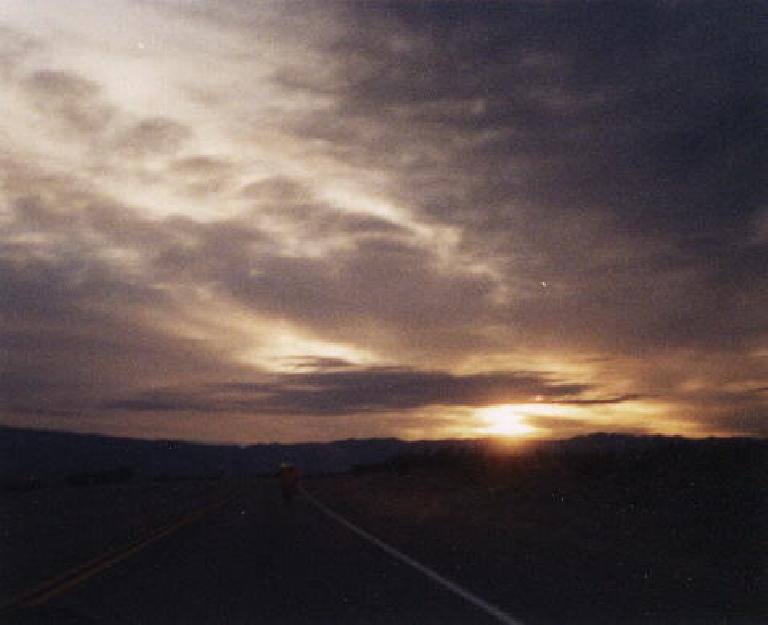
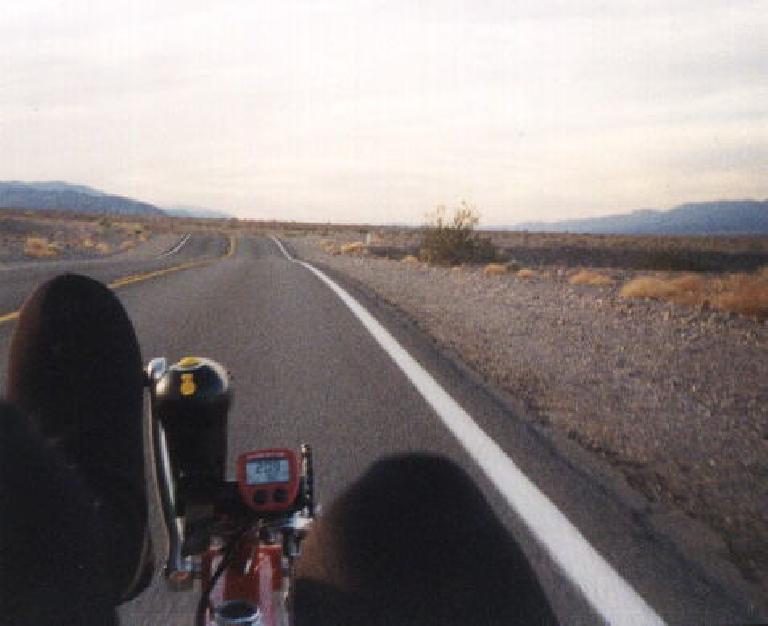
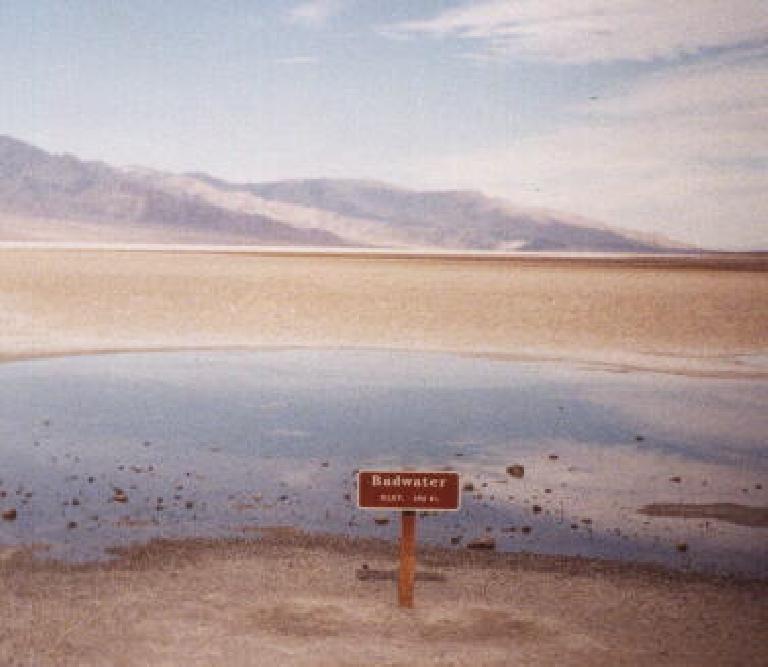
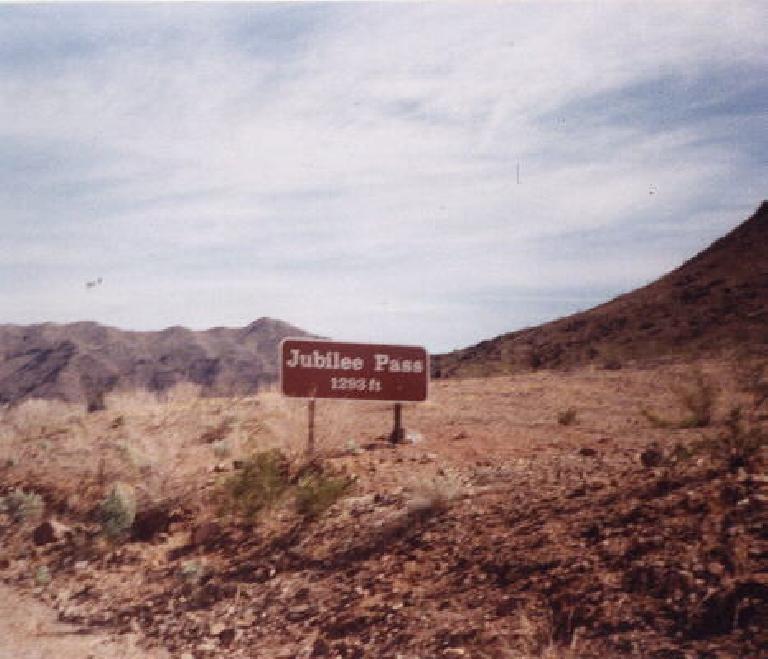
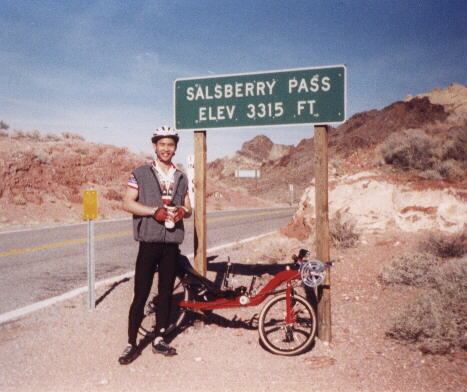
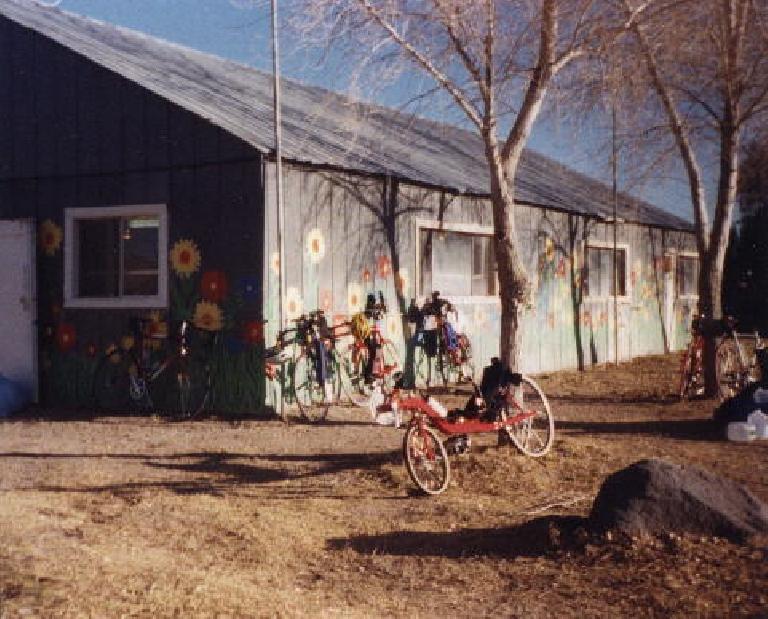

There are 2 comments.
I enjoyed your account of biking in Death Valley. Although I do not ride. The journal was interesting, since I just returned from a wonderful driving trip there.
Very interesting story! I have only driven through parts of Death Valley but have always wanted to go back. It is so intriguing.